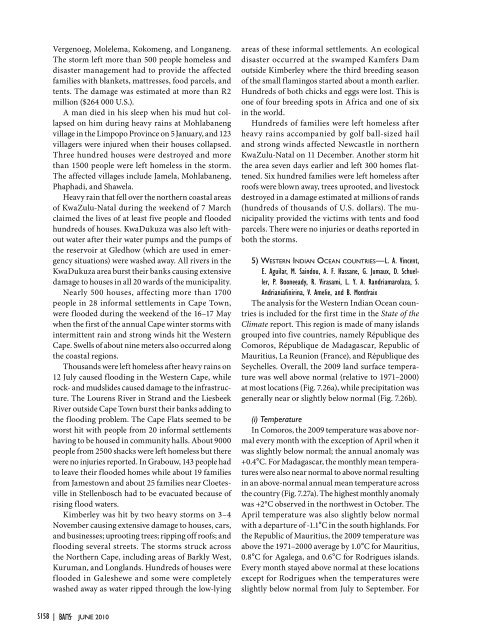You also want an ePaper? Increase the reach of your titles
YUMPU automatically turns print PDFs into web optimized ePapers that Google loves.
Vergenoeg, Molelema, Kokomeng, and Longaneng.The storm left more than 500 people homeless anddisaster management had to provide the affectedfamilies with blankets, mattresses, food parcels, andtents. The damage was estimated at more than R2million ($264 000 U.S.).A man died in his sleep when his mud hut collapsedon him during heavy rains at Mohlabanengvillage in the Limpopo Province on 5 January, and 123villagers were injured when their houses collapsed.Three hundred houses were destroyed and morethan 1500 people were left homeless in the storm.The affected villages include Jamela, Mohlabaneng,Phaphadi, and Shawela.Heavy rain that fell over the northern coastal areasof KwaZulu-Natal during the weekend of 7 Marchclaimed the lives of at least five people and floodedhundreds of houses. KwaDukuza was also left withoutwater after their water pumps and the pumps ofthe reservoir at Gledhow (which are used in emergencysituations) were washed away. All rivers in theKwaDukuza area burst their banks causing extensivedamage to houses in all 20 wards of the municipality.Nearly 500 houses, affecting more than 1700people in 28 informal settlements in Cape Town,were flooded during the weekend of the 16–17 Maywhen the first of the annual Cape winter storms withintermittent rain and strong winds hit the WesternCape. Swells of about nine meters also occurred alongthe coastal regions.Thousands were left homeless after heavy rains on12 July caused flooding in the Western Cape, whilerock- and mudslides caused damage to the infrastructure.The Lourens River in Strand and the LiesbeekRiver outside Cape Town burst their banks adding tothe flooding problem. The Cape Flats seemed to beworst hit with people from 20 informal settlementshaving to be housed in community halls. About 9000people from 2500 shacks were left homeless but therewere no injuries reported. In Grabouw, 143 people hadto leave their flooded homes while about 19 familiesfrom Jamestown and about 25 families near Cloetesvillein Stellenbosch had to be evacuated because ofrising flood waters.Kimberley was hit by two heavy storms on 3–4November causing extensive damage to houses, cars,and businesses; uprooting trees; ripping off roofs; andflooding several streets. The storms struck acrossthe Northern Cape, including areas of Barkly West,Kuruman, and Longlands. Hundreds of houses wereflooded in Galeshewe and some were completelywashed away as water ripped through the low-lyingareas of these informal settlements. An ecologicaldisaster occurred at the swamped Kamfers Damoutside Kimberley where the third breeding seasonof the small flamingos started about a month earlier.Hundreds of both chicks and eggs were lost. This isone of four breeding spots in Africa and one of sixin the world.Hundreds of families were left homeless afterheavy rains accompanied by golf ball-sized hailand strong winds affected Newcastle in northernKwaZulu-Natal on 11 December. Another storm hitthe area seven days earlier and left 300 homes flattened.Six hundred families were left homeless afterroofs were blown away, trees uprooted, and livestockdestroyed in a damage estimated at millions of rands(hundreds of thousands of U.S. dollars). The municipalityprovided the victims with tents and foodparcels. There were no injuries or deaths reported inboth the storms.5) Western Indian Ocean countries—L. A. Vincent,E. Aguilar, M. Saindou, A. F. Hassane, G. Jumaux, D. Schueller,P. Booneeady, R. Virasami, L. Y. A. Randriamarolaza, S.Andrianiafinirina, V. Amelie, and B. MontfraixThe analysis for the Western Indian Ocean countriesis included for the first time in the State of theClimate report. This region is made of many islandsgrouped into five countries, namely République desComoros, République de Madagascar, Republic ofMauritius, La Reunion (France), and République desSeychelles. Overall, the <strong>2009</strong> land surface temperaturewas well above normal (relative to 1971–2000)at most locations (Fig. 7.26a), while precipitation wasgenerally near or slightly below normal (Fig. 7.26b).(i) TemperatureIn Comoros, the <strong>2009</strong> temperature was above normalevery month with the exception of April when itwas slightly below normal; the annual anomaly was+0.4°C. For Madagascar, the monthly mean temperatureswere also near normal to above normal resultingin an above-normal annual mean temperature acrossthe country (Fig. 7.27a). The highest monthly anomalywas +2°C observed in the northwest in October. TheApril temperature was also slightly below normalwith a departure of -1.1°C in the south highlands. Forthe Republic of Mauritius, the <strong>2009</strong> temperature wasabove the 1971–2000 average by 1.0°C for Mauritius,0.8°C for Agalega, and 0.6°C for Rodrigues islands.Every month stayed above normal at these locationsexcept for Rodrigues when the temperatures wereslightly below normal from July to September. ForS158 | juNE 2010
















